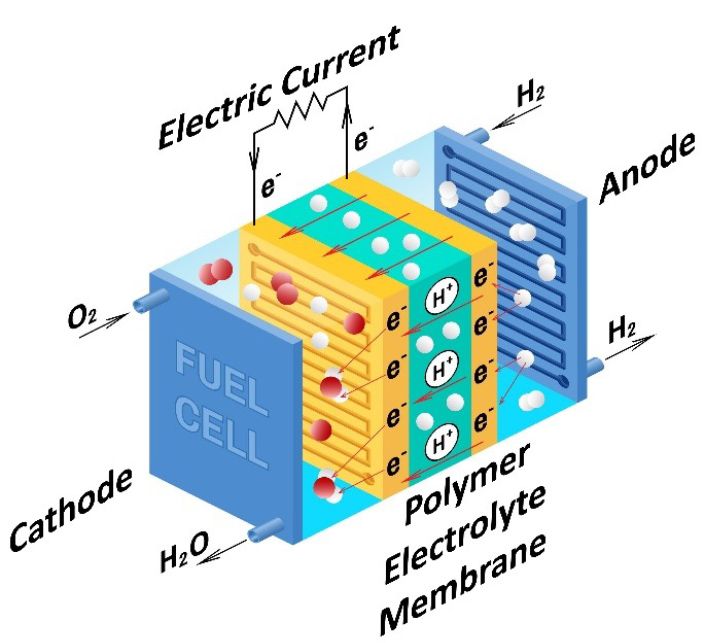Electric, solar, and nuclear All of these terms signify major improvements in biochemical renewable sources. But what do they mean? And is that where our future lies? The sustainable technology of our future is much more diverse than portrayed in mainstream media; unraveling the complexities of their development and impact speculates which energy sources will, or will not, be popular investments.
Electrochemical Fuel Cells
Perhaps the biggest technological advance came in the form of batteries. Batteries follow the same concept as many different forms of renewable energy: there’s a cathode and an anode, and electrons are being exchanged. For a general term, these will be referred to as fuel cells.
The most popular type of fuel cell is a hydrogen fuel cell. A few car manufacturers tried to produce hybrid hydrogen fuel cell cars, which are barely selling right now. The Chicago CTA is trying to transition into hydrogen buses. The hype is there, but is the technology?
Fuel cell technology is a dream. A good dream, actually, not a daydream. It’s a type of energy that is readily available because it only requires hydrogen and oxygen. And there are no emissions. Just energy and water vapor. Pure hydrogen is fed into the anode (-), and electrolysis splits the atom into a proton and an electron. The protons pass through a proton exchange membrane, which is in the middle of the cathode and anode. Electrons are blocked by such a membrane, so they travel externally, creating an electric current. At the cathode, oxygen gas is fed and reacts with hydrogen protons to make water (H2O).

So if it’s so perfect, why is it not common? It’s because the raw material needed is pure hydrogen gas. It takes a lot of energy to turn something common, like methane (CH4) into hydrogen. Typically, this is done with petroleum because it’s cheaper, defeating the point of a renewable energy source by creating emissions.
Fuel cells, in general, are an extremely popular research topic. So far, only California has put it to commercial use, but expect a proliferation of the market within the upcoming decade!
Biomass
A much more complete and developed concept is that of biofuels or energy created from biological origins. Take a stick of celery. It has a sugar called cellulose that’s common to most plants. Cellulose undergoes fermentation with the help of specific microorganisms that eat it up and excrete organic acids. These organic acids are then separated and processed, turning them into biofuels.
Biofuels are incredibly compatible with the current petroleum-based infrastructure. Take jet fuel, for example. It has very stringent applications, and alternatives to current jet fuels need to ensure they combust the same way within engines; otherwise, a plane crash is a serious business. Jet fuel is around 50–60% kerosene, which is a fancy word for simple carbon chains. These carbon chains are typically sourced from petroleum refineries, but we can also get them from plants. They are all built from carbon, after all. And once these biofuels (like butanol, for example) are created, we can simply drop them into airplane engines, and it will work.
Biofuels are by far the most readily available technology and the best alternative to petroleum right now. Although carbon emissions are still created via combustion, the process of refining fuel is less carbon intensive, and using organic matter is much more sustainable than fossil fuels. Moreover, current biofuel blends, although more expensive, have less of an environmental impact; even when they do, like if we made plastics from plants, most of them can be taken up by natural processes, mainly because they were made via natural processes.
The next steps come with separation. When microorganisms finish fermentation, the resulting liquid is a mix of random acids, water, and our desired organic compound. Separating this slurry is necessary for biofuel production, and this happens to cost around 40% of total costs. With more efficient, scaled-up methods, we can even look to replace our gas in cars with biofuels.
Realistically…
I recently met with the Vice President of Boeing Corporate Strategy. When I asked him about his take on sustainability and renewable energy, he brought up a crucial concept. Commercially, although promising, technologies like fuel cells are expensive and inefficient. It doesn’t pass the money test. So it has to pass the governmental test. The government must make some use of renewable energies (say it finds that biofuels are more effective in F-22 jets), and then there will be more subsidies and investments. Otherwise, the private sector will struggle to move away from fossil fuels because they are cheaper, better understood, and more reliable.
So the future starts with technology and government. Once we prove to the people in power that the promise of renewable energy extends beyond the lab, we can look for sustainable, cost-effective, and affordable implementations that benefit our communities and beyond.






Be the first to comment on "What’s Next for the Renewable Energy Sector"